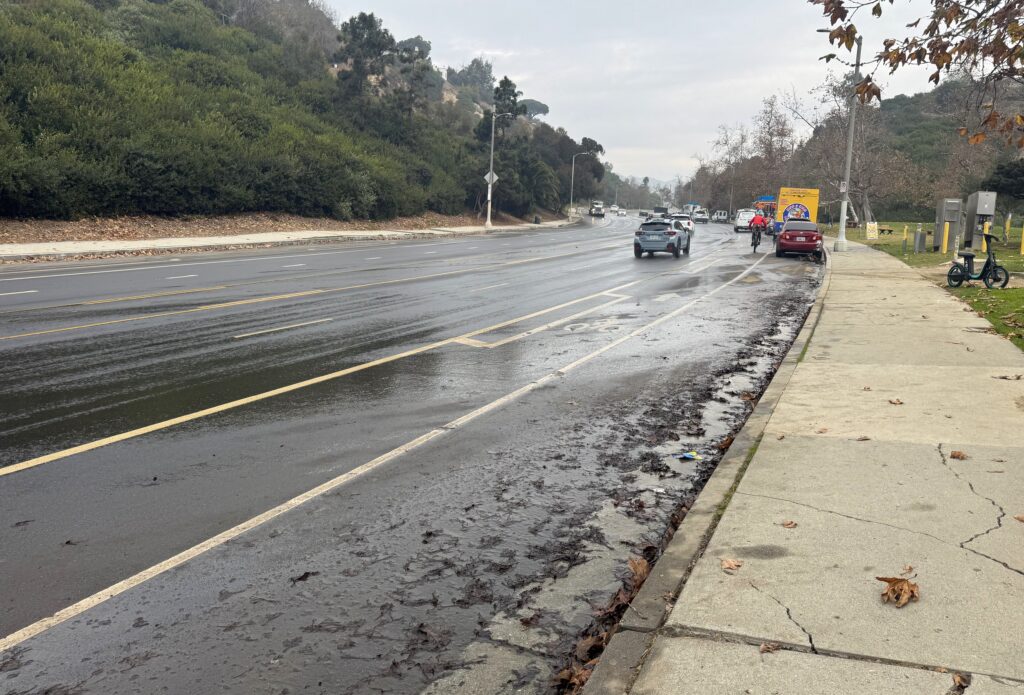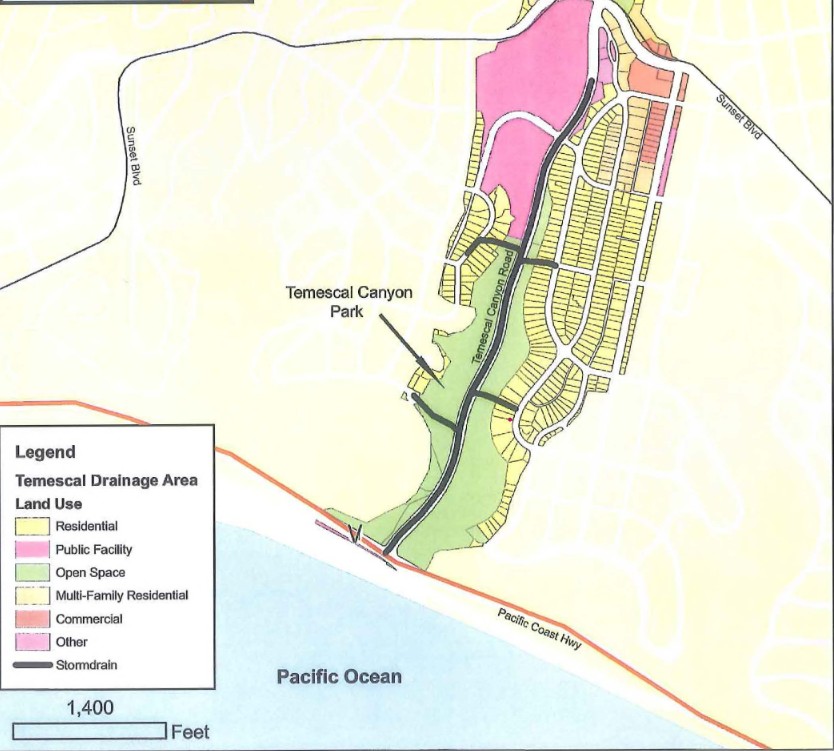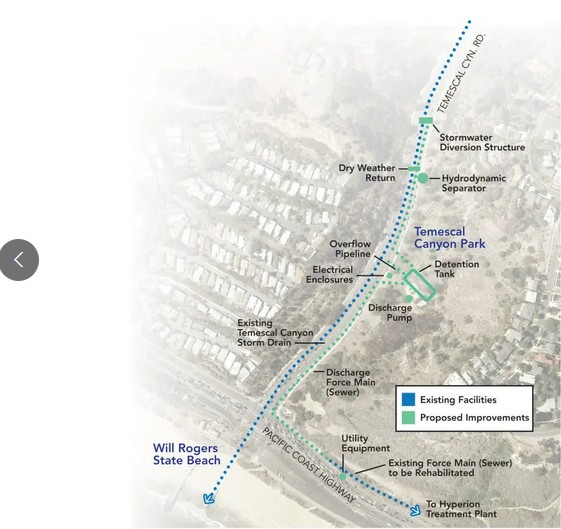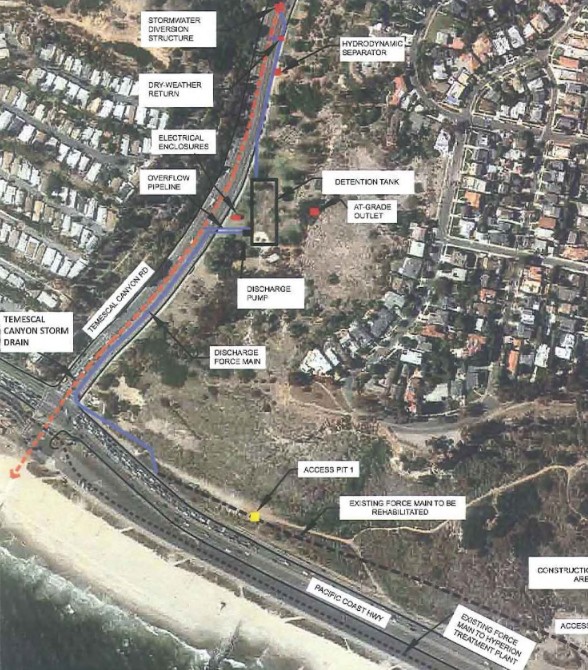
Although the City of LA asks residents to conserve water, it does not follow its own advice, allowing this water to flow unchecked for nearly a month on Temescal Canyon Road.
Many residents have complained about the “River” that has been flowing down four lanes of Temescal Canyon Road for about the last three weeks. One resident even speculated that the City is not repairing it in order to allow salmon to swim upstream.
More likely the leak is tied to Proposition O construction that closed lanes of Temescal, while underground reservoirs were dug, new pipes installed, and a hydrodynamic separator constructed. The first phase of construction was 2012 – 2013. The second phase was 2016-2018.
This editor, a reporter in 2009 asked who would be responsible for the maintenance and was told that the Bureau of Sanitation would clean it after each rain event and prior to the start of the rainy season.
Resident Chris Spitz wanted assurance that before construction began, adequate funding will be in place to clean and maintain the proposed hydro-separator.
Spitz said, “‘We have learned from credible residents that the hydro-separator at the Sun Valley stormwater diversion project is rarely if ever maintained or cleaned, leading to the malfunctioning of that facility.’”
Residents were told that the $500 million in Proposition O money was not targeted towards maintenance and there were no provisions yet for the Temescal project.
The proposed project would implement on-site treatment and reuse retained stormwater (Phase I) for the irrigation of Temescal Canyon Park, thereby promoting water conservation.
This diversion system would filter rain from the 1,600-acre watershed area that encompasses El Medio on the west, Via de la Paz on the east, and the ridge line of the Santa Monica Mountains to the north.
Then Michelle Vargas, spokesperson for the Department of LA Public Works, said that although the Palisades was a low-pollution area, that the Temescal location was selected because it is a city-owned property.
The diversion system would be housed underground at three sites in the canyon. Stormwater would go in a diversion tank (16 ft. by 12 ft. and 24 ft. deep), which is about a quarter of a way up the canyon (from PCH).
From that tank the water would drain into the hydrodynamic separator, while the cleaned water continues towards the beach to the holding tank.
The separator is 16 ft. in diameter and will be buried 25 ft. below ground, with a 5-ft. by 5-ft. hatch being the only visible feature at the surface.
The holding tank was constructed and buried under a playing field and the playground area (many may remember a worker was trapped and died in 2012, shutting construction down). This tank is 166 ft. by 66 ft. and 30 ft. deep.
After construction, the field and playground were built on top of the tank.
At that 2009 meeting DOT Engineer Mohammad Blorforoshan, explained how lanes of Temescal would be closed, including k-rails and restriping.
The most recent activity at the site, which is just above Pacific Coast Highway by the bathrooms and playgrounds, was in 2022. The pumps located in the holding tanks were pumping too much water for the size of the pipes, which meant irrigation from the tank could not occur. The pumps were replaced by Geosyntec, a consulting and engineering firm, that had been hired by the City.
(The Project included the construction of: “a 120-foot stormwater line from 500 gallon per minute (gpm) pump located inside an existing buried reservoir to the treatment building; a 31’4” by 13’4” (416.3 square feet) treatment building (to include two (2) peristaltic booster pumps; self-cleaning 200 micron filter with a flow capacity of 2,000 gpm; 490 gallon double-contained tank on a raised platform; treatment agent will be sodium-hypochlorite at 12.5% solution) constructed with a fire suppression system; exterior air conditioning condenser unit; a 2,530-foot treated water distribution line from the treatment building to the existing Temescal Canyon Park Irrigation System, of which 2,372-feet will be located within the right-of-way of Temescal Canyon Road; and a 10-foot wide gravel road to provide access to the treatment building from Temescal Canyon Road.” )
(Editor’s note: a resident has asked through the public information act, for dates when the hydrodynamic separator was cleaned. Arus Grigoryan, the new CD 11 field deputy for Pacific Palisades has been in touch with members of the community council and this editor was told that basins need to be cleaned by County “vector trucks,” which doesn’t make sense, since this is City property and was a City project. Below is the original 2009 story.)
January 1, 2009
The City of Los Angeles Department of Public Works plans to construct a $15.9-million diversion system along Temescal Canyon Road that will be used solely for rainstorm runoff from October through April, if it obtains local city coastal approval and Coastal Commission approval.
Ideally, stormwater will one day drain into a diversion tank that feeds into a hydro-separator, which separates out pollutants such as trash and oil. The debris remains in the hydro-separator and the water flows into a 1.3-million-gallon cement-reinforced holding tank at the bottom of Temescal Canyon Park (just north of Pacific Coast Highway), where it will stay for up to three days before being sent to the Hyperion Treatment Center in El Segundo.
The LADPW plans to finance construction from Proposition O, which passed in 2004 and allowed the city to issue up to $500 million in general bonds for watershed projects that clean up and prevent pollution of waterways and beaches.
The diversion system will filter rain from the 1,600-acre watershed area that encompasses El Medio on the west, Via de la Paz on the east, and the ridge line of the Santa Monica Mountains to the north, which means a great deal of the runoff comes from parkland. That area does not have a high concentration of trash and toxins such as used motor oil, antifreeze, fertilizers, pesticides and pet waste, which are the most common stormwater pollutants, according to Michelle Vargas, spokesperson for the Department of Public Works. Despite being a low-pollution site, the Temescal location was selected for the facility because it is on city-owned property.
The diversion system will be housed underground at three sites in the canyon. The first stop for the stormwater will be the diversion tank (16 ft. by 12 ft. and 24 ft. deep). From that tank the water drains into the hydrodynamic separator, while the cleaned water continues towards the beach to the holding tank. The separator is 16 ft. in diameter and will be buried 25 ft. below ground, with a 5-ft. by 5-ft. hatch being the only visible feature at the surface.
The holding tank will be buried under a playing field and playground area. This tank is 166 ft. by 66 ft. and 30 ft. deep. After construction, the field and playground will be reinstated. Construction is expected to start next September and take about a year. Temescal Canyon Road, of course, is a major artery in and out of the Palisades.
At a December 5 public hearing at the Palisades Branch Library, Bureau of Engineering Temescal Stormwater Project Manager Andy Flores said that the bike lane and sidewalk on both sides of the road would remain open, but that traffic could be reduced to one lane each way.
Community activist George Wolfberg asked that a traffic study be presented to the Pacific Palisades Community Council. ’The traffic plans for this project are currently being developed in compliance with L.A. Department of Transportation requirements,’ Vargas said. ‘The project team will be able to inform residents about it when it is finalized, sometime towards the end of project design in the spring of 2009.’
At the public hearing, several audience members wondered if there were sensors in the system in order to alert that the hydro-separator needed to be cleaned. Although the audience was told that there are no other existing systems like this, and that it is state-of-the-art, the hydro-separator and the holding tank would have to be visually inspected to see if they need cleaning.
Maintenance will be done on a routine scheduled basis per manufacturer’s indication,’ Vargas told the Palisadian-Post on Tuesday. ‘The [1.3-million-gallon] tank will also be maintained on a regular scheduled basis.’ He added, ‘As in any bond measure, the Prop. O funds passed by L.A. voters and approved by the L.A. City Council only cover the cost of construction.’
“Unfortunately, ‘All of the Prop. O money has been committed,’ said Alex Fey, the Legislative and Environmental Officer for Councilman Bill Rosendahl’s office on Tuesday. ‘We’re looking for an ongoing funding source, maybe a property assessment. We’re looking at different options.’”




As a resident of the Palisades, I am keen to understand how the system functions and contributes to stormwater management and environmental conservation in the area. If possible, I would like the sanitation department to schedule a visit to observe the filtration system in action and gain insights into its design, operation, and impact.
Pacific Palisades, where one of the biggest problems is freshly washed cars being dirtied while driving up and down Temescal. On the bright side, at least people have something to complain about besides the taco stand.